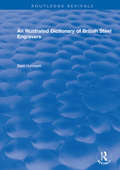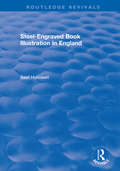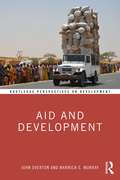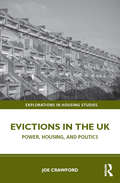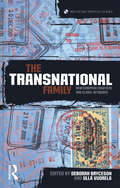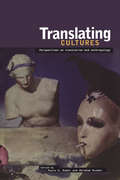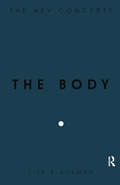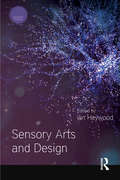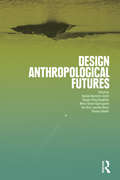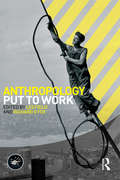- Table View
- List View
Ancient Lives: An Introduction to Archaeology and Prehistory
by Brian M. Fagan Nadia DurraniFocusing on sites of key significance and the world’s first civilizations, Ancient Lives is an accessible and engaging textbook which introduces complete beginners to the fascinating worlds of archaeology and prehistory. Drawing on their impressive combined experience of the field and the classroom, the authors use a jargon-free narrative style to enliven the major developments of more than 3 million years of human culture. First introducing the basic principles, methods, and theoretical approaches of archaeology, the book then provides a summary of world prehistory from a global perspective. This latest edition provides an up-to-date account of human evolution and the origins of modern humans. It explores the reality of life in the prehistoric world. Later chapters describe the development of agriculture and animal domestication, and the emergence of cities, states, and preindustrial civilizations in widely separated parts of the world. Our knowledge of these is changing thanks to revolutionary developments in LIDAR (light detection and ranging) technology and other remote-sensing devices. With this new edition updated to reflect the latest discoveries and research in the discipline, Ancient Lives continues to be a comprehensive and essential introduction to archaeology. It will be ideal for students looking for an accessible guide to the subject.
Gender and Rights (Key Concepts in Indigenous Studies)
by G. N. Devy Geoffrey V. DavisPart of the series Key Concepts in Indigenous Studies, this book focuses on the concepts that recur in any discussion of nature, culture and society among the indigenous. This book, the second in a five-volume series, deals with the two key concepts of gender and rights of indigenous peoples from all continents of the world. With contributions from renowned scholars, activists and experts across the globe, it looks at issues of indigenous human rights, gender justice, repression, resistance, resurgence and government policies in Canada, Latin America, North America, Australia, India, Brazil, Southeast Asia and Africa. Bringing together academic insights and experiences from the ground, this unique book with its wide coverage will serve as a comprehensive guide for students, teachers and scholars of indigenous studies. It will be essential reading for those in gender studies, human rights and law, social and cultural anthropology, tribal studies, sociology and social exclusion studies, religion and theology, cultural studies, literary and postcolonial studies, Third World and Global South studies, as well as activists working with Indigenous communities.
Sustainable Development in India: Groundwater Irrigation, Energy Use, and Food Production (Routledge New Horizons in South Asian Studies)
by Koichi Fujita Tsukasa MizushimaThis book explores and interrogates the food–water–energy nexus, arguably the most crucial factor in sustaining India’s economic development. The book sheds light on different experiences faced in states across India, including the consequences of electricity tariff reforms and related policies on irrigated agriculture. Part 1 focuses on the historical development of agriculture and social change in India, with special reference to the mode of responses and adaptations in social systems against the inherent low and erratic rainfall and resulting water stress in India during the pre-colonial period. Additionally, it investigates how colonial development destroyed social systems and discusses future development prospects. Part 2 discusses contemporary issues of agriculture and social change in India. A comprehensive examination of various important issues related to South Asian agricultural development in the past and in the present, this book will be a valuable reference for researchers of Asian development, sustainable development, environmental policy, South Asian Studies and Development Studies.
Ancient Lives: An Introduction to Archaeology and Prehistory
by Brian M. Fagan Nadia DurraniFocusing on sites of key significance and the world’s first civilizations, Ancient Lives is an accessible and engaging textbook which introduces complete beginners to the fascinating worlds of archaeology and prehistory. Drawing on their impressive combined experience of the field and the classroom, the authors use a jargon-free narrative style to enliven the major developments of more than 3 million years of human culture. First introducing the basic principles, methods, and theoretical approaches of archaeology, the book then provides a summary of world prehistory from a global perspective. This latest edition provides an up-to-date account of human evolution and the origins of modern humans. It explores the reality of life in the prehistoric world. Later chapters describe the development of agriculture and animal domestication, and the emergence of cities, states, and preindustrial civilizations in widely separated parts of the world. Our knowledge of these is changing thanks to revolutionary developments in LIDAR (light detection and ranging) technology and other remote-sensing devices. With this new edition updated to reflect the latest discoveries and research in the discipline, Ancient Lives continues to be a comprehensive and essential introduction to archaeology. It will be ideal for students looking for an accessible guide to the subject.
Gender and Rights (Key Concepts in Indigenous Studies)
by G. N. Devy Geoffrey V. DavisPart of the series Key Concepts in Indigenous Studies, this book focuses on the concepts that recur in any discussion of nature, culture and society among the indigenous. This book, the second in a five-volume series, deals with the two key concepts of gender and rights of indigenous peoples from all continents of the world. With contributions from renowned scholars, activists and experts across the globe, it looks at issues of indigenous human rights, gender justice, repression, resistance, resurgence and government policies in Canada, Latin America, North America, Australia, India, Brazil, Southeast Asia and Africa. Bringing together academic insights and experiences from the ground, this unique book with its wide coverage will serve as a comprehensive guide for students, teachers and scholars of indigenous studies. It will be essential reading for those in gender studies, human rights and law, social and cultural anthropology, tribal studies, sociology and social exclusion studies, religion and theology, cultural studies, literary and postcolonial studies, Third World and Global South studies, as well as activists working with Indigenous communities.
Sustainable Development in India: Groundwater Irrigation, Energy Use, and Food Production (Routledge New Horizons in South Asian Studies)
by Koichi Fujita Tsukasa MizushimaThis book explores and interrogates the food–water–energy nexus, arguably the most crucial factor in sustaining India’s economic development. The book sheds light on different experiences faced in states across India, including the consequences of electricity tariff reforms and related policies on irrigated agriculture. Part 1 focuses on the historical development of agriculture and social change in India, with special reference to the mode of responses and adaptations in social systems against the inherent low and erratic rainfall and resulting water stress in India during the pre-colonial period. Additionally, it investigates how colonial development destroyed social systems and discusses future development prospects. Part 2 discusses contemporary issues of agriculture and social change in India. A comprehensive examination of various important issues related to South Asian agricultural development in the past and in the present, this book will be a valuable reference for researchers of Asian development, sustainable development, environmental policy, South Asian Studies and Development Studies.
A Political Biography of Aung San Suu Kyi: A Hybrid Politician (Politics in Asia)
by Michał LubinaThis book is the first political biography of Aung San Suu Kyi covering both her years in opposition and all her years in power from 2016 onwards. It offers a new interpretation of Aung San Suu Kyi by presenting a balanced and thorough account of Suu Kyi’s policies. In the last 30 years there has not been a person in global politics who has risen so high and fallen so low – and so quickly – as Aung San Suu Kyi. Using postcolonial theory and introducing the new concept of `a hybrid politician', this book explains apparent inconsistencies of Suu Kyi’s agenda. It demonstrates that Suu Kyi considers herself a democrat and yet, rules autocratically. Immersed in her country’s tradition of policymaking, she has at the same time been influenced by foreign concepts, both Western and Asian. Drawing on first-hand research, including talks with Suu Kyi, conversations with her supporters and rivals, observations of Suu Kyi’s behaviour during intergovernmental talks as well as an extensive number of sources and fieldwork in Myanmar, the author argues that Suu Kyi’s case shows both the strengths and limits of hybridity. This brings Suu Kyi priceless political assets such as visibility, recognition and support while proving that such a model of leadership has its restrictions. A timely biography of the Nobel Peace Prize Laureate as she appears at the International Court of Justice to defend her country against charges of genocide committed against the Rohingya Muslim minority, this book will be of interest to students and researchers of Myanmar politics, Southeast Asian politics, Asian politics, Political Science more generally, Postcolonial Studies, Cultural Studies and Leadership Studies.
Indian Social Work
by Bishnu Mohan Dash Mithilesh Kumar Siddheshwar Shukla D. P. SinghThis book provides multiple frameworks and paradigms for social work education which integrates indigenous theories and cultural practices. It focuses on the need to diversify and reorient social work curriculum to include indigenous traditions of service, charity and volunteerism to help social work evolve as a profession in India. The volume analyzes the history of social work education in India and how the discipline has adapted and changed in the last 80 years. It emphasizes the need for the Indianization of social work curriculum so that it can be applied to the socio-cultural contours of a diverse Indian society. The book delineates strategies and methods derived from meditation, yoga, bhakti and ancient Buddhist and Hindu philosophy to prepare social work practitioners with the knowledge, and skills, that will support and enhance their ability to work in partnership with diverse communities and indigenous people. This book is essential reading for teachers, educators, field practitioners and students of social work, sociology, religious studies, ancient philosophy, law and social entrepreneurship. It will also interest policy makers and those associated with civil society organizations.
Indian Social Work
by Bishnu Mohan Dash; Mithilesh Kumar; D. P. Singh; Siddheshwar ShuklaThis book provides multiple frameworks and paradigms for social work education which integrates indigenous theories and cultural practices. It focuses on the need to diversify and reorient social work curriculum to include indigenous traditions of service, charity and volunteerism to help social work evolve as a profession in India. The volume analyzes the history of social work education in India and how the discipline has adapted and changed in the last 80 years. It emphasizes the need for the Indianization of social work curriculum so that it can be applied to the socio-cultural contours of a diverse Indian society. The book delineates strategies and methods derived from meditation, yoga, bhakti and ancient Buddhist and Hindu philosophy to prepare social work practitioners with the knowledge, and skills, that will support and enhance their ability to work in partnership with diverse communities and indigenous people. This book is essential reading for teachers, educators, field practitioners and students of social work, sociology, religious studies, ancient philosophy, law and social entrepreneurship. It will also interest policy makers and those associated with civil society organizations.
An Illustrated Dictionary of British Steel Engravers (Routledge Revivals)
by Basil HunnisettFirst published in 1989, An Illustrated Dictionary of British Steel Engravers contains more than 600 entries and an extensive plate section, providing examples of work referenced in the text and adding a clear chronological dimension to the subject. The book makes use of an array of surviving accounts and correspondence of engravers and publishers and adopts a comprehensive and systematic approach to identifying different types and variants of steel engravings over time. Equipped with a detailed introduction to the history of steel engravings, An Illustrated Dictionary of British Steel Engravers will be of great use to those interested in illustration, graphic art, Victorian literature, and the history of printing.
Steel-Engraved Book Illustration in England (Routledge Revivals)
by Basil HunnisettFirst published in 1980, Steel-Engraved Book Illustration in England is a detailed and comprehensive survey of the steel engravings that were so popular in the nineteenth century. With an extensive range of illustrations, the book refutes the assumption that steel engravings are of little artistic value or importance, a common attitude rooted largely in the connection between steel engravings and mass-produced books. Beginning with an exploration of the identification problems and early history of steel engravings, it moves through the production and printing of the plates and on to a study of several engravers and artists, as well as of the books themselves. Steel-Engraved Book Illustration in England will appeal to anyone interested in the history of printing and illustration.
An Illustrated Dictionary of British Steel Engravers (Routledge Revivals)
by Basil HunnisettFirst published in 1989, An Illustrated Dictionary of British Steel Engravers contains more than 600 entries and an extensive plate section, providing examples of work referenced in the text and adding a clear chronological dimension to the subject. The book makes use of an array of surviving accounts and correspondence of engravers and publishers and adopts a comprehensive and systematic approach to identifying different types and variants of steel engravings over time. Equipped with a detailed introduction to the history of steel engravings, An Illustrated Dictionary of British Steel Engravers will be of great use to those interested in illustration, graphic art, Victorian literature, and the history of printing.
Steel-Engraved Book Illustration in England (Routledge Revivals)
by Basil HunnisettFirst published in 1980, Steel-Engraved Book Illustration in England is a detailed and comprehensive survey of the steel engravings that were so popular in the nineteenth century. With an extensive range of illustrations, the book refutes the assumption that steel engravings are of little artistic value or importance, a common attitude rooted largely in the connection between steel engravings and mass-produced books. Beginning with an exploration of the identification problems and early history of steel engravings, it moves through the production and printing of the plates and on to a study of several engravers and artists, as well as of the books themselves. Steel-Engraved Book Illustration in England will appeal to anyone interested in the history of printing and illustration.
Aid and Development (Routledge Perspectives on Development)
by John Overton Warwick E. MurrayThis book provides an overview of what aid is, how it has changed over time and how it is practiced, as well as debates about whether aid works, for whom and what its future might be. The text shows how ‘aid’ is a contested and fluid concept that involves a wide and changing variety of policies, actors and impacts. It equips the reader with an understanding of what aid is, where it comes from and where it goes, how it is delivered and what its impacts are, and whether shortcomings are a result of a fundamental problem with aid, or merely the result of bad practices. It explores the changing political ideologies and conceptions of development that continually reshape how aid is defined, implemented and assessed, and how, despite a global commitment to the Sustainable Development Goals, we are at a point where the very notion of aid is being questioned and its future is uncertain. Each chapter includes case studies, chapter summaries, discussions, weblinks and further reading, to help strengthen the reader’s understanding. Aid and Development provides an important resource for students, development workers and policy makers seeking an understanding of how aid works.
Aid and Development: The Inverse Sovereignty Effect In The Pacific Islands (Routledge Perspectives on Development)
by John Overton Warwick E. MurrayThis book provides an overview of what aid is, how it has changed over time and how it is practiced, as well as debates about whether aid works, for whom and what its future might be. The text shows how ‘aid’ is a contested and fluid concept that involves a wide and changing variety of policies, actors and impacts. It equips the reader with an understanding of what aid is, where it comes from and where it goes, how it is delivered and what its impacts are, and whether shortcomings are a result of a fundamental problem with aid, or merely the result of bad practices. It explores the changing political ideologies and conceptions of development that continually reshape how aid is defined, implemented and assessed, and how, despite a global commitment to the Sustainable Development Goals, we are at a point where the very notion of aid is being questioned and its future is uncertain. Each chapter includes case studies, chapter summaries, discussions, weblinks and further reading, to help strengthen the reader’s understanding. Aid and Development provides an important resource for students, development workers and policy makers seeking an understanding of how aid works.
Evictions in the UK: Power, Housing, and Politics (Explorations in Housing Studies)
by Joe CrawfordEvictions in the UK examines the relationships between tenants, landlords, housing providers and government agencies and the tensions and conflicts that characterise these relations. The book shows how power dynamics are being reconfigured in the post-welfare context of the first quarter of the 21st century, as evictions for rent arrears are becoming one of the most significant threats to both the wellbeing of the social housing sector and the welfare of its tenants. Embracing both practical and critical approaches, this book offers a comprehensive understanding of the contradictory and thus controversial issue of evictions. It explores the range of perspectives involved in the practice – landlords carrying out evictions, those agencies providing legal assistance to evictees, as well as academics and institutions charged with researching and regulating the process. Drawing on three case studies relating to evictions across Scotland and England, this book provides a comprehensive look at the punitive consequences of poverty (evictions for rent arrears) and status (evictions under immigration law) that are applicable to social housing systems worldwide. Based on original, primary-source data, this book will be a key resource for academics and students as well as policy makers and practitioners in the fields of housing studies, planning, social welfare, and political sociology.
Evictions in the UK: Power, Housing, and Politics (Explorations in Housing Studies)
by Joe CrawfordEvictions in the UK examines the relationships between tenants, landlords, housing providers and government agencies and the tensions and conflicts that characterise these relations. The book shows how power dynamics are being reconfigured in the post-welfare context of the first quarter of the 21st century, as evictions for rent arrears are becoming one of the most significant threats to both the wellbeing of the social housing sector and the welfare of its tenants. Embracing both practical and critical approaches, this book offers a comprehensive understanding of the contradictory and thus controversial issue of evictions. It explores the range of perspectives involved in the practice – landlords carrying out evictions, those agencies providing legal assistance to evictees, as well as academics and institutions charged with researching and regulating the process. Drawing on three case studies relating to evictions across Scotland and England, this book provides a comprehensive look at the punitive consequences of poverty (evictions for rent arrears) and status (evictions under immigration law) that are applicable to social housing systems worldwide. Based on original, primary-source data, this book will be a key resource for academics and students as well as policy makers and practitioners in the fields of housing studies, planning, social welfare, and political sociology.
The Supreme Court’s Role in Mass Incarceration
by William T. PizziThe Supreme Court’s Role in Mass Incarceration illuminates the role of the United States Supreme Court’s criminal procedure revolution as a contributing factor to the rise in U.S. incarceration rates. Noting that the increase in mass incarceration began climbing just after the Warren Court years and continued to climb for the next four decades—despite the substantial decline in the crime rate—the author posits that part of the explanation is the Court’s failure to understand that a trial system with robust rights for defendants is not a strong trial system unless it is also reliable and efficient. There have been many explanations offered for the sudden and steep escalation in the U.S. incarceration rate, such as "it was the war on drugs" to "it was our harsh sentencing statutes." Those explanations have been shown to be inadequate. This book contends that we have overlooked a more powerful force in the rise of our incarceration rate—the long line of Supreme Court decisions, starting in the Warren Court era, that made the criminal justice system so complicated and expensive that it no longer serves to protect defendants. For the vast majority of defendants, their constitutional rights are irrelevant, as they are forced to accept plea bargains or face the prospect of a comparatively harsh sentence, if convicted. The prospect of a trial, once an important restraint on prosecutors in charging, has disappeared and plea-bargaining rules. This book is essential reading for both graduate and undergraduate students in corrections and criminal justice courses as well as judges, attorneys, and others working in the criminal justice system.
The Supreme Court’s Role in Mass Incarceration
by William T. PizziThe Supreme Court’s Role in Mass Incarceration illuminates the role of the United States Supreme Court’s criminal procedure revolution as a contributing factor to the rise in U.S. incarceration rates. Noting that the increase in mass incarceration began climbing just after the Warren Court years and continued to climb for the next four decades—despite the substantial decline in the crime rate—the author posits that part of the explanation is the Court’s failure to understand that a trial system with robust rights for defendants is not a strong trial system unless it is also reliable and efficient. There have been many explanations offered for the sudden and steep escalation in the U.S. incarceration rate, such as "it was the war on drugs" to "it was our harsh sentencing statutes." Those explanations have been shown to be inadequate. This book contends that we have overlooked a more powerful force in the rise of our incarceration rate—the long line of Supreme Court decisions, starting in the Warren Court era, that made the criminal justice system so complicated and expensive that it no longer serves to protect defendants. For the vast majority of defendants, their constitutional rights are irrelevant, as they are forced to accept plea bargains or face the prospect of a comparatively harsh sentence, if convicted. The prospect of a trial, once an important restraint on prosecutors in charging, has disappeared and plea-bargaining rules. This book is essential reading for both graduate and undergraduate students in corrections and criminal justice courses as well as judges, attorneys, and others working in the criminal justice system.
The Transnational Family: New European Frontiers and Global Networks
by Deborah BrycesonMigrant networks, in the form of families, associational ties and social organizations, stretch across the globe, connecting cultures and bridging national boundaries. The effects of this global networking are vast. This book is the first to stand back and explore the impact. Families living outside of their original national boundaries have had, and continue to have, a profound influence over the flow of people, goods, money and information. More in-depth perspectives reveal how immigrants face troubling issues of cultural identity, economic change, political uncertainty and social welfare. From an examination of nineteenth-century transnational families emigrating from Europe, to the Ghanaian Pentecostal diaspora in Europe today, this book combines broadly based analysis with more unusual case studies to reveal the complexities that immigrants and refugees must contend with in their daily lives. What are the experiences of migrant Turkish women living in Germany? In what ways has religion been hybridized amongst West African Muslim migrants in Paris? What are the gender relations and transnational ties amongst Bosnian refugees? Never has such a topic been more relevant. Problems relating to immigrants' and refugees' situations in their adopted countries continue to grow. This book, wide-ranging in its geographical and thematic scope, is a highly important and timely addition to debates on transnational families, immigrants and refugees.
Translating Cultures: Perspectives on Translation and Anthropology
by Paula G. RubelThe task of the anthropologist is to take ideas, concepts and beliefs from one culture and translate them into first another language, and then into the language of anthropology. This process is both fascinating and complex. Not only does it raise questions about the limitations of language, but it also challenges the ability of the anthropologist to communicate culture accurately. In recent years, postmodern theories have tended to call into question the legitimacy of translation altogether. This book acknowledges the problems involved, but shows definitively that ‘translating cultures' can successfully be achieved. The way we talk, write, read and interpret are all part of a translation process. Many of us are not aware of translation in our everyday lives, but for those living outside their native culture, surrounded by cultural difference, the ability to translate experiences and thoughts becomes a major issue. Drawing on case studies and theories from a wide range of disciplines -including anthropology, philosophy, linguistics, art history, folk theory, and religious studies - this book systematically interrogates the meaning, complexities and importance of translation in anthropology and answers a wide range of provocative questions, such as: - Can we unravel the true meaning of the Christian doctrine of trinity when there have been so many translations? - What impact do colonial and postcolonial power structures have on our understanding of other cultures? - How can we use art as a means of transgressing the limitations of linguistic translation? Translating Cultures: Perspectives on Translation and Anthropology is the first book fully to address translation in anthropology. It combines textual and ethnographic analysis to produce a benchmark publication that will be of great importance to anthropologists, philosophers, linguists, historians, and cultural theorists alike.
The Body: The Key Concepts (The\key Concepts Ser.)
by Lisa BlackmanQuestions around 'the body' are central to social theory. Our changing understanding of the body now challenges the ways we conceive power, ideology, subjectivity and social and cultural process. The Body: the key concepts highlights and analyses the debates which make the body central to current sociological, psychological, cultural and feminist thinking. Today, questions around the body are intrinsic to a wide range of debates - from technological developments in media and communications, to socio-cultural questions around representation, performance, class, race, gender and sexuality, to the more 'physical' concerns of health and illness, sleep, diet and eating disorders, body parts and the senses.The Body: the key concepts is the ideal introduction for any student seeking a concise and up-to-date analysis of the complex and influential debates around the body in contemporary culture.
Sensory Arts and Design (Sensory Studies)
by Ian HeywoodArtists, designers and researchers are increasingly seeking new ways to understand and explore the creative and practical significance of the senses. This ground-breaking book brings art and design into the field of sensory studies providing a clear introduction to the field and outlining important developments and new directions. A compelling exploration of both theory and practice, Sensory Arts and Design brings together a wide variety of examples from contemporary art and design which share a sensory dimension in their development or user experience. Divided into three parts, the book examines the design applications of new technology with sensing capacities; the role of the senses in creating new imaginative environments; and the significance of the senses within different cultural practices. The thirteen chapters cover a highly diverse range of issues – from the urban environment, architecture and soundscapes to gustatory art, multisensory perception in painting, music and drawing, and the relationship between vision and smell. Initiated by Insight, a research group at Lancaster Institute for the Contemporary Arts –widely recognised as a center of research excellence – the project brings together a team of experts from Britain, Europe and North America. This timely book is destined to make a significant contribution to the scholarly development of this emerging field. An important read for students and scholars in sensory studies, design, art, and visual culture.
Design Anthropological Futures: Exploring Emergence, Intervention And Formation (Criminal Practice Ser.)
by Rachel Charlotte Smith Kasper Tang Vangkilde Mette Gislev Kjærsgaard Ton Otto Joachim Halse Thomas BinderA major contribution to the field, this ground-breaking book explores design anthropology’s focus on futures and future-making. Examining what design anthropology is and what it is becoming, the authors push the frontiers of the discipline and reveal both the challenges for and the potential of this rapidly growing transdisciplinary field.Divided into four sections – Ethnographies of the Possible, Interventionist Speculation, Collaborative Formation of Issues, and Engaging Things – the book develops readers’ understanding of the central theoretical and methodological aspects of future knowledge production in design anthropology. Bringing together renowned scholars such as George Marcus and Alison Clarke with young experimental design anthropologists from countries such as Denmark, Sweden, Austria, Brazil, the UK, and the United States, the sixteen chapters offer an unparalleled breadth of theoretical reflections and rich empirical case studies.Written by those at the forefront of the field, Design Anthropological Futures is destined to become a defining text for this growing discipline. A unique resource for students, scholars, and practitioners in design anthropology, design, architecture, material culture studies, and related fields.
Anthropology Put to Work (Wenner-Gren International Symposium Series)
by Les W. Field Richard G. FoxHow do anthropologists work today and how will they work in future? While some anthropologists have recently called for a new "public" or "engaged" anthropology, profound changes have already occurred, leading to new kinds of work for a large number of anthropologists. The image of anthropologists "reaching out" from protected academic positions to a vaguely defined "public" is out of touch with the working conditions of these anthropologists, especially those junior and untenured. The papers in this volume show that anthropology is put to work in diverse ways today. They indicate that the new conditions of anthropological work require significant departures from canonical principles of cultural anthropology, such as replacing ethnographic rapport with multiple forms of collaboration. This volume's goal is to help graduate students and early-career scholars accept these changes without feeling something essential to anthropology has been lost. There really is no other choice for most young anthropologists.





